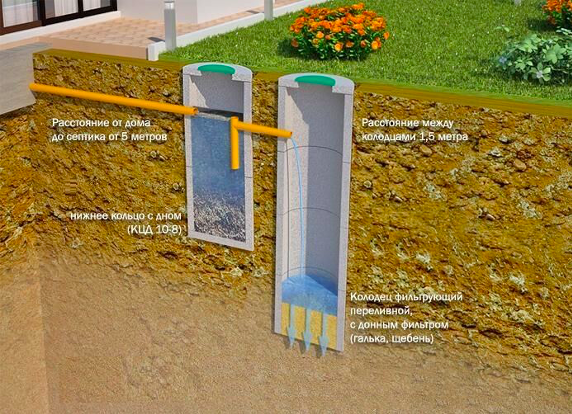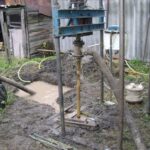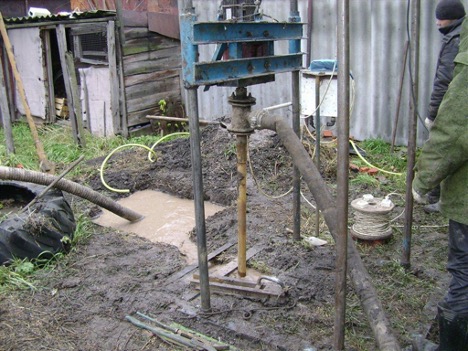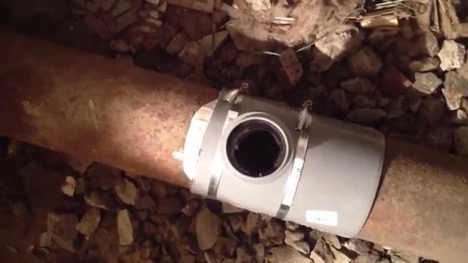Cesspool made of concrete rings with overflow: what the device looks like
In modern conditions of country life, a cesspool made of concrete rings is one of the most common and time-tested solutions for a local wastewater treatment system. This device allows you to reliably and effectively solve sanitation issues on the site. Especially if it is not connected to the central sewer. In this article we will look at how a cesspool made of concrete rings with an overflow is constructed. We will also evaluate its advantages and the main stages of installation.

The content of the article
Basic operating principles and benefits
A ring cesspool is a structure consisting of several concrete rings stacked on top of each other to form a closed volume for collecting wastewater. The main difference between a cesspool made of concrete rings and an overflow is the presence of an overflow system, which avoids overfilling the pit and ensures its longer functioning without the need for frequent pumping.
The advantages of such a solution are numerous:
- the construction of a cesspool made of concrete rings ensures high strength and durability of the structure;
- the possibility of self-installation - concrete rings can be installed with your own hands without the involvement of specialized equipment, which significantly reduces the total cost of work;
- environmental safety - concrete does not react with waste and does not allow pollution to enter the soil.
Installation stages
Turnkey installation of a cesspool made of concrete rings includes several key steps. Before starting work, it is necessary to prepare the site and select the optimal location for the pit, taking into account the depth of groundwater and the distance to sources of drinking water.
Basic installation steps:
- Dig a pit of a suitable size, ensuring the installation of the required number of rings with a reserve for overflow.
- Install concrete rings, starting from the bottom level, ensuring their tightness at the joints using special sealants.
- Organize an overflow system, which includes installing an additional chamber or installing an overflow device to redirect excess drainage.
When implementing a project, it is important to consider how to install a country toilet on concrete rings to ensure maximum efficiency and ease of use. The optimal solution would be to place the toilet directly above the cesspool, which will simplify the drainage system and minimize the risk of contamination of the area.
Advantages of self-installation
One of the significant advantages of a cesspool made of concrete rings is the ability to install it yourself. This not only saves money, but also allows you to precisely meet the individual requirements and characteristics of the site.
For those who decide to install the system with their own hands, it is important to know:
- correct selection and calculation of the number of rings depending on the expected load;
- techniques for sealing connections between rings to prevent leaks;
- methods of strengthening and insulating the outer surface of the pit to protect against the penetration of groundwater.

Mistakes when installing a cesspool made of concrete rings with your own hands
Installing a cesspool from concrete rings with your own hands is a process that requires attention to detail and knowledge of certain nuances. Despite its apparent simplicity, during the work you may encounter a number of errors that will lead to a decrease in the efficiency of the system or its complete failure. Let's look at the most common of them.
One of the main mistakes is the wrong choice of location for a cesspool made of concrete rings. It is important to consider the distance to drinking water sources, residential buildings and site boundaries to avoid contamination and the spread of unpleasant odors. In addition, without taking into account the level of groundwater, you may encounter its penetration into the pit, which will significantly worsen the conditions of its operation and can lead to soil contamination.
Another common mistake is improper installation and sealing of connections between concrete rings. This can lead to leaks and seepage of wastewater into the soil, which will not only worsen the environmental situation on the site, but will also shorten the service life of the pit itself. Using low-quality seals or completely ignoring them when installing ring elements is a critical mistake that should be avoided.
Finally, underestimating the need to organize an overflow system or improperly designing it can cause the cesspool made of concrete rings to overflow and the waste to leak onto the surface of the ground. This will not only create problems with sanitation and hygiene on the site, but will also require additional costs for regular pumping of the contents of the pit, thereby reducing its operational efficiency and ease of use.
Careful planning, attention to detail during installation, and the use of quality materials will help you avoid these and other mistakes.
Conclusion
A cesspool made of concrete rings with an overflow is a reliable, durable and environmentally friendly solution for organizing a local wastewater treatment system in summer cottages and suburban areas. Thanks to the possibility of self-installation and a wide selection of ready-made solutions, each site owner can choose the best option that suits his needs and capabilities.





